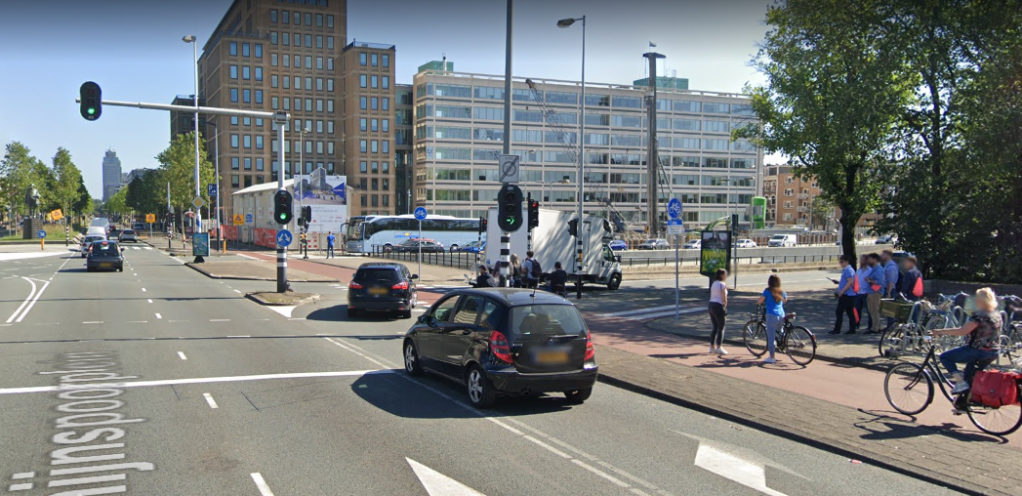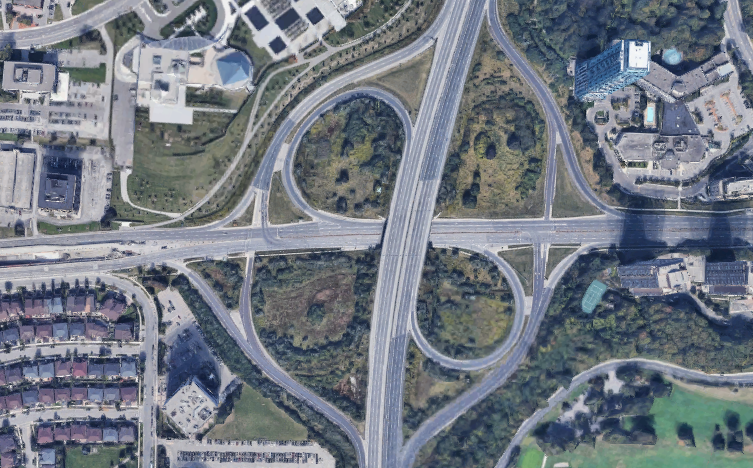Interchanges are often the only option for crossing freeways, and these can be challenging to navigate for people walking or riding bikes. By bringing the design of these crossings into the spotlight, we can remove one of the biggest barriers to walking and cycling in many communities.
Freeways are the pinnacle of the automotive transport system. Every day, hundreds of thousands of vehicles whip by at high speeds, transporting people and goods over long distances. These roadways are essential to our economies, but they also form major barriers in the cities and communities they cut through. Bridges and underpasses are expensive so crossing points are limited, funneling all road users through high-volume, uncomfortable settings.
Crossing a freeway is one of the most stressful areas to ride a bicycle or walk. At a typical urban or suburban freeway interchange with ramps, a vulnerable road user has to cross at least two free-flow ramps, plus one or two additional signalized intersections. The free-flow on-ramps are designed for high volume, high-speed traffic flows with little regard for cyclist and pedestrian safety.

Pedestrians must wait for a gap to cross these ramps and wait for a signal at intersections, worsening safety and adding delay. Cyclists may fare even worse, having to cross ramp entrances with turning traffic cutting across, or getting stuck in long “floating bike lanes”.

Bikeway design manuals are beginning to propose safer facility designs at interchanges. Instead of the floating bike lane, one alternative pictured below is to keep cyclists alongside pedestrians and allow them to both cross on-ramps perpendicularly. This is no doubt an improvement, but it is nowhere near the level of design needed to support all-ages-and-abilities cycling – pedestrians and cyclists must still wait for gaps in high-volume, fast traffic flows, with no crossing priority.

The challenge with many bikeway design manuals is they treat the properties of the road network as fixed, and the cycling facility as something that must adapt to suit it. Cyclists are retrofitted into the motor vehicle system. But what if we drop that assumption, and instead assume that the freeway can be modified to support the cyclist and pedestrian? New and improved solutions can begin to emerge.
Signalize the Ramps
Without changing the geometry of the interchange at all, conflicts between vulnerable road users and motorists can be mitigated by simply controlling the free-flow on-ramp crossings with signals. Doing so also allows for accessible crossings with audible signals for people who are partially sighted. If motor vehicle volumes are high though, it is likely that the signals will be programmed with long green times for motorists and long wait times for pedestrians and cyclists, improving safety at the cost of travel time. This could easily double or triple the time it takes to cross a highway if multiple ramps are signalized.

Square the Ramps
What if we consider the geometry of the interchange to be flexible? One of the simplest changes geometrically is to remove the free-flow on-ramps and instead require motorists to access on-ramps at signalized intersections where pedestrians and cyclists have crossing priority.


Still, turning volumes will be high, and unless a dedicated signal phase is provided, vulnerable road users may face an unacceptable number of conflicting traffic volumes. The Dutch CROW manual recommends that where a bikeway crosses the path of right-turning motorists, the two movements should have separate signals when the turning vehicle volume exceeds 150 per hour. At freeway on-ramps, this volume is typically several hundred (if not thousands) per hour, so it is imperative that separated signals be considered.

Shift the Ramps to One Side
Squaring the ramps allows some improvement but still places cyclists and pedestrians in many conflicting situations with high volumes of traffic and likely adds more wait time at intersections. The next level of improvement is a change to the orientation of the interchange altogether.
The traditional interchange looks nice and symmetric, with opposing loops that ensure traffic entering the highway always does so by turning right, saving time for motorists. In this scenario, cyclists and pedestrians on each side of the road have the same number of uncomfortable conflict points.
By shifting the configuration so that on-ramps are only on one side of the overpass, conflicts can be completely eliminated on one side of the street. With one side dedicated to motor vehicle access, pedestrians and cyclists cross on the other side, with a sidewalk and two-way cycling facility. Not only does this mitigate all conflicts for cyclists and pedestrians, it allows them to bypass traffic signals, significantly reducing delay. In essence, this design behaves as a separate underpass for pedestrians and cyclists parallel to the interchange.

This of course will have impacts to traffic, which will need to turn left to access the freeway instead of turning right. One positive for traffic signals is that removing pedestrians and cyclists from these intersections provides more flexibility for operating the intersections, since timing doesn’t need to reflect pedestrian crossings.

Create a Separate Crossing
There will always be interchanges that are so critical to the motor vehicle network that compromises to their design cannot be made for the safety of pedestrians and cyclists. In this case, the solution is to provide a separate crossing altogether. This is by far the most expensive solution, easily costing over $10 million, but the benefits are many. Walking and cycling networks can be oriented around these crossings, rather than relying on interchange crossings. At each end of the bridge, motor vehicle volumes will naturally be lower, making them more suitable transition points into the surrounding community.

In many cases, secondary roadways already cross freeways without interchanges and the design of these can be prioritized for people walking and cycling instead at a fraction of the cost.
Different Modes, Different Needs
Creating freeways with limited crossings where all road users converge at high-volume, high-speed crossings is not an equitable design for all road users and favours the motorist. This in turn creates barriers to walking and cycling, forcing more people into cars for transportation. By treating these modes differently at the network level, and bringing the design of freeway interchanges into the spotlight, we can greatly improve conditions for walking and cycling.


An interesting alternative is building a park on top of a highway. In Dallas, Texas, US they built Klyde Warren Park, (done by a private foundation then donated to the city). The park connects Downtown with Uptown, which had a highway run right between the two. Before they were distinctly two sperate areas, now bridge the popular Uptown and add vibrancy to Downtown (preventing it to become a ghost town after 5pm). Walkable and has a trolly run across Uptown to reach the Arts District museums at the edge of Downtown. The foundation provides Events, “selected” Food Trucks, a Dog Park, Kid Playground, water features, two restaurants, maintained greenery. I’m pretty amazed at what this small park alone provides for the Greater Dallas area. I have friends from the suburbs that drive all the way to the park for their kids to play with the water.
LikeLike
Wow such a great example of bridging a gap with a space for people, thanks for sharing. Something I didn’t mention in the post is that even when the highway crossing doesn’t involve on-ramps (such as an urban underpass), it can still be very unpleasant and divides communities. Putting pedestrian friendly amenities and parks there can help bridge that uncomfortable gap.
LikeLike